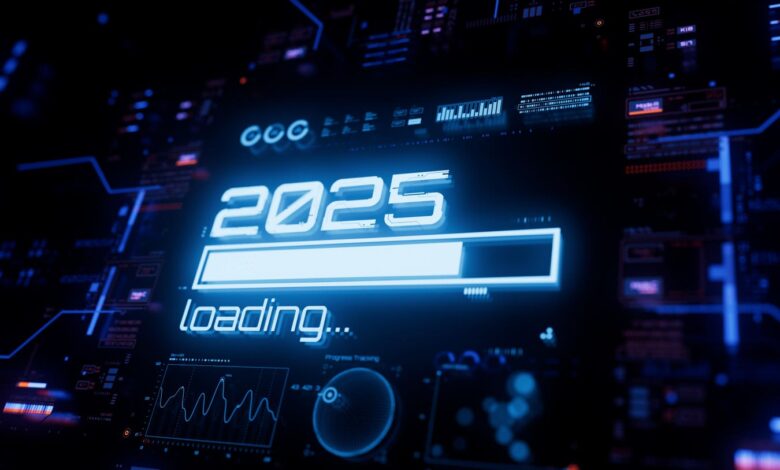Top 10 game-changing predictions for 2025 for AI, Blockchain, and Business

2025 is almost here
With the holidays quickly approaching and the prospect of a few days of well-deserved rest, everyone wants some indulgent and “feel good” news to carry them into 2025. Many forecasts will focus on Bitcoin’s recent rise, and make no mistake: the rise in its value is great news for everyone involved in Building the future powered by blockchain technology.
But the price of Bitcoin is like those chocolate coins you find at the bottom of your stash: sweet and fun, but ultimately unsatisfying. The best gifts are those that bring us joy, sustenance, and value in the long term, complementing the sugar rush caused by higher prices in the short term.
So, let’s reveal some of the most important trends that will define the decentralized economy in the coming year, and propel AI, cryptocurrencies, quantum, and blockchain to great success in 2025. These things are tough, so tell me where you agree or disagree!
1. Bitcoin corporate treasuries rise
Corporate adoption of Bitcoin will reach a turning point in 2025 as major companies follow MicroStrategy’s pioneering approach to treasury management. This shift will go beyond just asset diversification – companies will integrate Bitcoin into their operational strategies, using it as collateral for loans, employee compensation, and international payments.
Bitcoin. (Photo illustration by Dan Kitwood/Getty Images)
Traditional financial institutions will respond by launching end-to-end crypto services, including bitcoin-backed mortgages and cryptocurrency-collateralized lines of credit. Mainstreaming Bitcoin into corporate finance will stabilize cryptocurrency markets, reducing the volatility that has historically deterred institutional investors.
Amazon shareholders have already taken a leaf out of MicroStrategy’s book and recommended the company Diversification in Bitcoin To beat inflation and increase value. I expect to see at least five Fortune 500 companies allocate more than 5% of their treasury reserves to Bitcoin by the end of the year.
2. The era of upcoming practices
“Best practices” will be governed by “next practices” as companies shift from replicating past successes to anticipating future opportunities.
Tesla exemplifies this by redefining automotive standards through direct-to-consumer sales, over-the-air upgrades, and integrated energy solutions, creating new revenue streams such as energy storage and software subscriptions. Likewise, Netflix has transformed media by using artificial intelligence to predict viewer preferences, invest in original content, and set new global distribution standards.
Tesla and their upcoming practices. (Photo by Smith Collection/Gado/Getty Images).
This shift prioritizes AI-driven insight and experimentation, enabling companies to lead in disruptive industries such as retail and healthcare. The following practice is a forward-looking strategy that anticipates future opportunities rather than repeating past successes. I coined this term to emphasize innovation, experimentation, and predictive frameworks to create entirely new markets and disrupt traditional business models.
3. Small dramas take over
Ultra-short (1-5 minutes) “micro-dramas” will revolutionize entertainment with AI-generated stories that adapt in real-time to viewer engagement. Blockchain-based smart contracts will ensure that creators receive immediate funds, and are directly linked to audience retention and engagement.
Traditional studios will have a hard time keeping up with the speed and customization of AI-driven studios, with at least one exceeding $1 billion in value. In the words of one visionary, Anina Net, founder of Fashion Network and Actress 360, “In the future, stories will find you, not the other way around.”
Small Drama Group (Photo by Ma Jian/VCG via Getty Images)
Expect streaming giants to launch segments for smaller dramas while major actors collaborate with AI studios to create scalable, highly personalized content that captivates hearts in just minutes.
4. The rise of companies based on artificial intelligence
A new generation of companies will emerge, built from the ground up around AI capabilities. You will use these organizations Artificial intelligence in everything From strategic planning to daily operations, creating new standards for business efficiency and adaptability. Key features will include:
- Automated decision-making systems handle 80% of routine business processes
- AI-based talent acquisition and development software that predicts employee success with up to 90% accuracy
- Real-time market analysis and strategy adjustment capabilities
- Personalized customer experiences that instantly adapt to behavioral changes
This disruption will not come from legacy companies retrofitting AI into existing processes but from startups taking full advantage of AI in their vision. These AI-driven companies will rethink industries by building their entire structure around the transformative potential of AI.
As Navroop Sahdev, CEO and founder of Digital Economist, recently commented on a Factured Futures webinar, “AI-driven companies are not only leveraging technology, they are redefining the very fabric of how organizations operate. By building AI into their foundations These companies are setting new standards for speed, innovation and impact.
It’s exciting to see where new AI startups are going. The real revolution will be led by companies that integrate AI into their DNA, not those who try to install it on legacy systems.
5. Explainable AI becomes mandatory
In 2025, transparency in AI decision-making will become a regulatory imperative, driving the development of tools that make AI results clear and actionable. Companies will invest in “AI translators” to connect technical complexity to business needs, and natural language interfaces will become the standard for decision analysis.
As Hassan Sawaf, founder and CEO of AIXplain, says: “Explainability isn’t just a checkbox – it’s the key to unlocking the full potential of AI, and with guardian agents, organizations can finally exploit it safely and effectively.”
The advancement of artificial intelligence (Photo by Frederick J. Brown/AFP via Getty Images)
Organizations that embrace this transformation will turn compliance into a competitive advantage, building deeper trust with customers and partners through transparent and accountable AI.
6. AI-based “emotional marketing” will emerge
In 2025, marketing will move beyond personalization to emotion-driven strategies, powered by artificial intelligence capable of analyzing and predicting consumer sentiment in real time. Instead of targeting demographics or behavior alone, AI will leverage subtle emotions detected through text, voice, and video interactions to craft highly relevant campaigns that resonate on a deep, human level.
Imagine an AI system that adapts a brand message based on a consumer’s changing mood during a single interaction. For example, if someone is feeling stressed while browsing, AI can adjust the tone of messages to be soothing and reassuring, increasing the likelihood of engagement or purchase.
This level of emotional intelligence will not only boost ROI, but will also redefine consumer trust by making marketing feel truly empathetic. As I wrote in AI first, human always, “In 2025, the most successful brands will not only know their customers, they will understand their hearts, one emotion at a time.”
A adds. Lee Judge, content marketing expert and co-founder of Content Monsta: “AI-powered emotional marketing is the perfect tool for storytelling – it allows brands to meet customers exactly where they are, emotionally and contextually, creating connections that feel personal, engaging, and memorable.”
This shift will lead to entirely new tools for emotional analytics and spark discussions about the ethics of emotional manipulation, but for those who master it, the rewards will be transformative.
7. Extend the scope of the branded TLD
Adoption of branded top-level domains (TLDs) will accelerate as communities and businesses realize their ability to create controlled digital ecosystems. These .BRAND TLDs will become essential for customer loyalty programs, secure transactions, and verified digital identity systems.
Early adopters will use their TLDs to create exclusive digital spaces where customers can access personalized services, special offers, and unique content. This trend will especially impact e-commerce, as branded domains will provide an additional layer of security and trust for online transactions.
Top Level Domains (TLD)
Per Matthew Gould, CEO and Founder of Unstoppable Domains, “Businesses and communities will increasingly embrace their own TLDs (e.g., .BRAND), leveraging them to create immersive, loyalty-driven ecosystems in Web3 environments.” (Note: I work in unstoppable fields)
8. Regulatory green lights for cryptocurrencies
Clearer global regulations will open up unprecedented institutional investment in cryptocurrency markets. This organizational clarity will enable:
- Standardized compliance frameworks across key markets
- Integrating crypto assets into traditional investment portfolios
- Development of regulated crypto derivatives and ETFs
- Strengthening Consumer Protection Mechanisms The resulting market stability will attract conservative institutional investors who previously shunned crypto assets, leading to a more mature and reliable market structure.
9.Crypto boom: $16 trillion in real assets
The transfer of real assets will reach $16 trillion, radically changing the way we own and invest. Fractional ownership of high-value assets such as prime real estate and works of art will become mainstream, creating liquid markets for traditionally illiquid assets while reducing transaction costs and settlement times.
Real estate coding.
Traditional investment firms will scramble to build tokenization platforms, while real estate companies and art galleries tokenize their assets to attract global investors. “Tokenization turns real estate into portfolios and opens doors for investors everywhere,” says Nina Fabbri, CEO of PropyKeys.
This shift will democratize the ability to access high-value opportunities, ensuring that anyone can own a piece of the future.
10. Quantity will be about Prototypes, proof-of-concept projects, and increased investment
Quantum computing It will still be in the early stages of adoption but will show tangible progress in solving specialized problems. Financial services will experiment with quantum algorithms for portfolio optimization and risk modeling, although most applications will remain in experimental stages. Pharmaceutical companies will continue to invest in quantitative research for drug discovery.
Quantum platforms as a service will become more accessible, enabling companies to experiment with quantum tools via cloud services. While large-scale applications are still years away, industries such as logistics and energy may begin testing quantum algorithms to address specific optimization challenges. On the cybersecurity front, quantum cryptography will receive attention, as companies begin to develop quantum-resistant security frameworks in preparation for future threats.
Although we won’t see quantum computing disrupt entire industries by 2025, the year will be marked by prototypes, proof-of-concept projects, and increased investment, as governments and companies prepare for the coming quantum era. Those at the forefront of these efforts will pave the way for the next wave of innovation, but scalability and debugging will remain major hurdles.
Convergence in expectations
These forecasts represent interconnected shifts that will fundamentally change how we interact with technology, content, and financial systems. Success in 2025 will require organizations to understand not only individual trends, but also how they intersect to create new opportunities. The winners will be those who can harness these technologies while maintaining a human-centered approach to innovation.
The future belongs to the organizations that can embrace these transformative technologies while creating real value for users. The question is not whether these changes will happen, but how quickly companies will be able to adapt to them and benefit from them.
Did you enjoy this story? Don’t miss my next article: Use the blue follow button at the top of the article near my byline to follow more of my work.
https://imageio.forbes.com/specials-images/imageserve/6768d82c55abedae5a9d7c00/0x0.jpg?format=jpg&height=900&width=1600&fit=bounds

